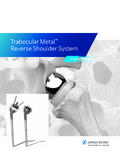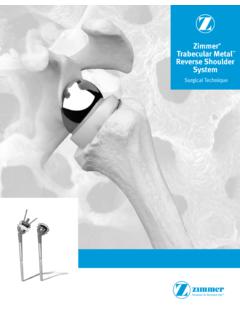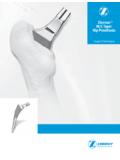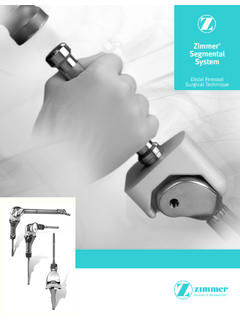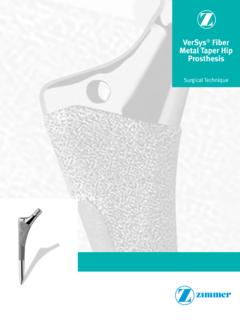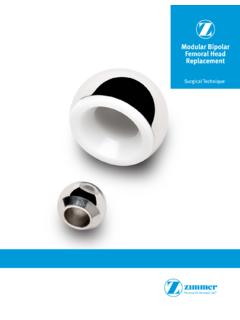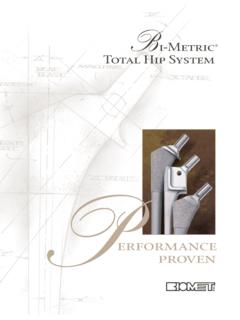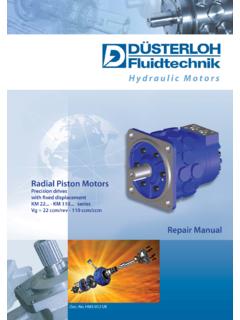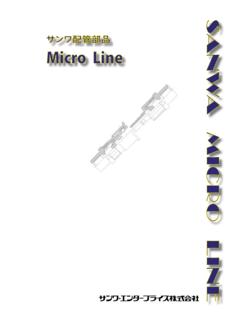Transcription of Zimmer Epsilon Durasul Constained Insert Surgical ...
1 1 Surgical Technique Zimmer Epsilon Durasul Constrained InsertSurgical TechniqueThe Problem:Dislocation is the second most common major complication in THA, occurring after - 7% of primary THAs and up to 19% of revision ,3,4,7 Dislocation can be physically destructive, leading to abductor tissue damage. Reoperation results in stability in only 69% of inserts are designed to reduce the incidence of dislocation. However, the design of traditional constrained inserts severely restricts ROM, leading to impingement. This may lead to component failure,8,5 dislocation,6,7 and implant Durasul Constrained InsertStability without compromiseThe Solution: Epsilon Durasul Constrained InsertCut-outs increase increase ROM where it is needed mostIn a study of 111 retrieved acetabular components, researchers identified two primary sites of impingement One site occurred where the neck impinged during full flexion or flexion plus internal rotation (anterior-superior).
2 The second site occurred where the neck impinged during external rotation in extension (posterior-inferior). Based on these findings, the Epsilon Durasul Constrained Insert was designed with cut-outs that may be placed where impingement is most likely to occur. For a left hip, the smaller, superior retaining finger is placed at one o clock to optimize fingers capture the head."Uilt on More than 0 Years oF #3Ti 0oroUs #oatinG clinical historY. Head diameters up to 38 mm to increase from Durasul Highly Crosslinked Polyethylene an advanced bearing surface that resists wear and 350300250200150100500 ZimmerJ&J (S-ROM)HowmedicaOsteonics(Omnifit)Lever- out Testing Lever-out of head from liner.(in - lbs)Constraining Functionality Retained In lever-out testing, the Epsilon Durasul Constrained Insert performed as well as two commonly used constrained Rotation at 90o FlexionExternal Rotation at 0o FlexionROM Testing Range of motion.
3 (degree)ROM Increased over Traditional Constrained InsertIn testing using a sawbones set-up and a three-dimensional goniometer, the Epsilon Durasul Constrained Insert demonstratedmuch-improved ROM when compared to a traditional : Epsilon Durasul Constrained InsertGrey: Osteonics Omnifit Constrained Insert1 Table of Contents:Joint Preparation and Shell Preparation ..2 Shell Placement ..2 Screw Fixation ..3 Trial Reduction and Range of of Constraining Head Ring Assembly to Constraining Ring Removal ..6 Polyethylene Insert Removal ..7 Bone Screw Method ..7 Osteotome Methods ..7 Important Information for the Durasul Constrained Insert Instrumentation ..13 Epsilon Durasul Constrained Inserts ..13 Universal Acetabular Instrumentation ..13 Sources 2 Joint ExposureNo specific type of incision or exposure is required for implantation of the Epsilon Durasul Constrained Insert .
4 The operation may be done using a Kocher-Langenbach posterolateral incision or a direct lateral incision, among others. The majority of cases utilizing constrained inserts are revision cases, and in these cases, the Kocher-Langenbach approach is common. In primary cases, either a posterolateral or direct lateral incision may be used. However, any approach that gives wide exposure of the acetabulum may be : To ensure proper impaction of the polyethylene liner, placement of constraining fingers, and assembly of the metal constraining ring, all soft tissue must be fully cleared/retracted to allow full visualization of the periphery of the acetabulum. This implant is not recommended at this time for use with a minimally invasive Preparation and Shell PlacementAcetabular PreparationThe Epsilon Durasul Constrained Insert is to be used only with a Converge Acetabular Shell or other Epsilon -compatible shell.
5 Standard operative procedures for the Converge Acetabular System should be used for acetabular preparation and shell implantation. In general, the preparation of the acetabular recess follows the usual guidelines, namely maximizing the contact with available host bone and maximizing the coverage with host PlacementThe recommended shell placement for use with the Epsilon Durasul Constrained Insert is slightly non-standard. That is, for most cases the optimum degree of abduction is about 55 , rather than 45 . Studies have demonstrated that increasingthe shell abduction to 55 increases the range of motion of the total hip ,16 Typically, abduction angles of this degree are not recommended because they may lead to a higher dislo-cation risk. However, since the head is constrained in this Insert design, the higher range of motion provided by the higher ab-duction angle does not increase the risk of dislocation.
6 Failure to abduct the shell to 55 will fail to optimize the range of motion of the Epsilon Durasul Constrained optimum degree of anteversion is standard, about 30 . Because anteversion is additive (meaning that the femoral anteversion and the acetabular anteversion should be added together in determining total anteversion), there is some Epsilon Durasul Constrained Insert Surgical TechniqueFigure 1 Polyethylene insertMetal constraining ringLarge Inferior Constraining FingerClocking tabSmall Superior Constraining FingerClocking slot3flexibility in the amount of anteversion of the acetabular component. For example, if a previously inserted femoral component is retained in a revision operation and is in neutral anteversion, the acetabular component should be anteverted more than usual. On the other hand, if the femoral componentis in more than the usual 15 of anteversion, then one needs to be sure that there is not excessive anteversion on the acetabular special feature of the use of larger femoral heads (>32 mm in diameter) is that the increased range of motion permits the use of a slightly increased amount of total anteversion.
7 Thus, if the femoral anteversion were at 15 , the larger head diameter would permit an increased amount of acetabular anteversion, such as 30 . Therefore, in revision cases where the femoral component is being retained, the surgeon should determine the degree of anteversion of the existing femoral component prior to determining the optimum anteversion for the acetabular FixationNote: In both primary and revision cases, screw fixation is highly recommended, as the use of any constrained Insert may lead to higher forces at the shell-to-bone augment both the initial stability and the long-term stability achieved through bony ingrowth. Screw placement follows the standard procedure for the Converge Acetabular System. The standard admonitions regarding the appropriateplacement and length of screws should be followed to maximizefixation and minimize the risk to neuro-vascular Reduction and Range of MotionBased on the size of the acetabular shell and femoral head to be used, the appropriate trial constrained Insert is selected.
8 The aim of the trial reduction is to locate the optimal rotationalposition of the constraining fingers (Figure 1) to maximize range of motion. This position may vary from patient to patient because of variations in anatomy and shell placement. For theinitial trial range of motion, the small superior constraining fingerof the appropriate-sized trial Insert is placed at approximately 1:00 for a left hip or 11:00 for a right hip (Figure 2). The trial Insert is rotationally secured by the interlock of the peripheralnotches on the trial with the anti-rotation pegs on the acetabularshell. The trial inserts contain a captured screw at the apex that is threaded into the dome of the acetabular shell with a straight hex-head screw driver (Figure 3).Figure 3 Figure 24 Warning: The captured screw is intended only to temporarily hold the trial Insert in place and should not be overly tight-ened.
9 Two-finger tightening is sufficient. Breakage can occur with excess torque on the captured screw. Note: The trial Insert is used only to assess leg length and range of motion. It does not constrain the femoral head, as the actual implant trial femoral head with the appropriate neck length is placed on the trunion of the femoral component and reduced into the trial Insert . After the leg length and femoral offset are verified, a trial range of motion is conducted. The key ranges of motion should be assessed, specifically: Maximum flexion in neutral rotation, Maximum internal rotation with 90 of flexion, Full extension (but not hyper-extension), Full external rotation in full the trial range of motion indicates that the orientation of theconstraining fingers does not optimize the range of motion, such asmight be indicated by premature neck- Insert impingement, the captured screw at the dome of the trial Insert can be released and the trial Insert rotated to another position.
10 Once the optimum orientation of the trial Insert is determined, the position of the small superior constraining finger is noted on the acetabular PlacementThe small superior constraining finger of the constrained liner is aligned in the acetabular shell to replicate the orientation that had provided optimum range of motion during assessmentusing the trial Insert (Figure 4). The appropriately sized constrainedinsert impactor is threaded onto the straight impactor handle until the threads are completely seated (Figure 5).Note: The constrained Insert impactors are sized according to the inner diameter of the Insert (or femoral head size). The constrained Insert impactor is placed onto the constrainedinsert such that the protruding polyethylene constraining fingers fit into annular recesses of the Insert impactor.
